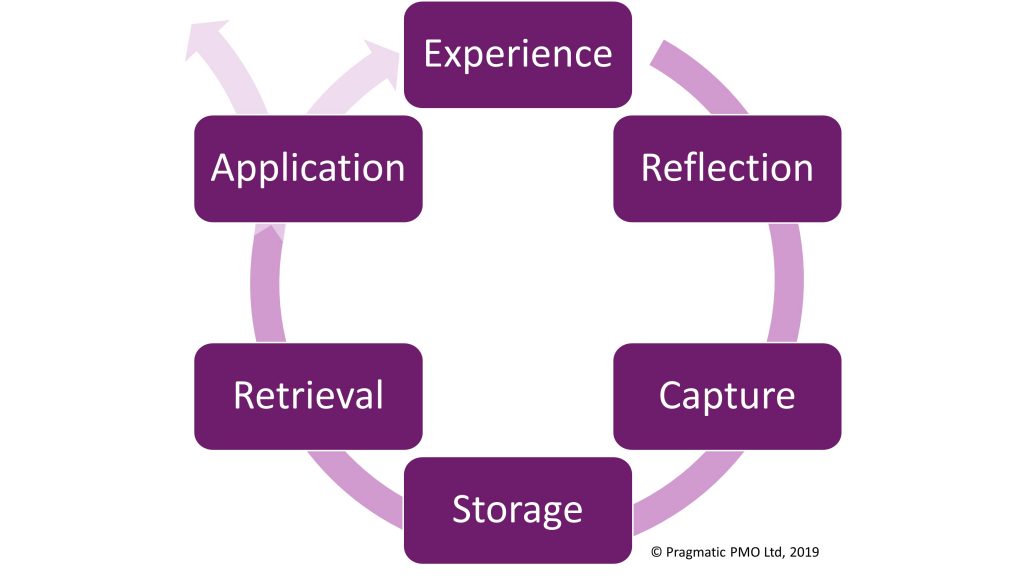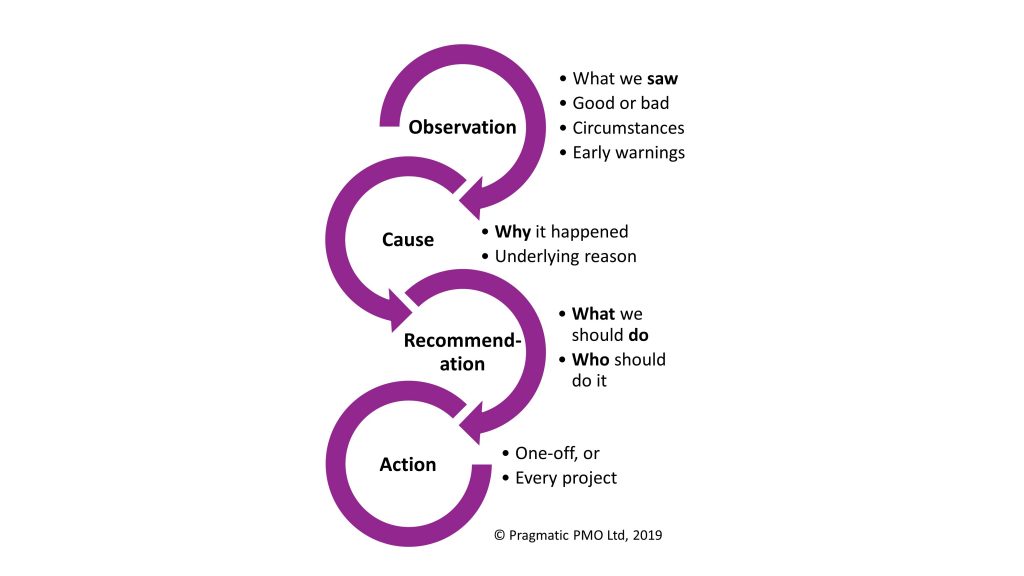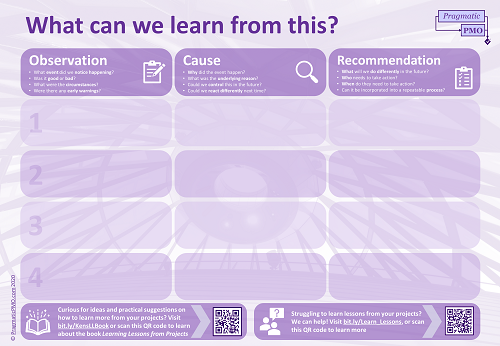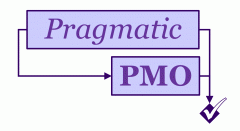If you’ve been following me for a while, you will probably know that I recently published a series of videos aimed at helping people who are looking for work in the wake of the impact that COVID19 has had on the world economy, and that I have a bit of a bee in my bonnet about learning lessons from experience.
So I thought I’d walk the talk and share with you the lessons I learned from the experience of producing my #OpenToWork video series using the steps in the lessons learned process framework that I describe in my book (Experience, Reflection, Capture, Storage, Retrieval, Application) so that you can see it in action.

Experience
The process starts with an individual’s personal experience of the day-to-day events that happen as part of running a project or activity. In this case I am considering is the experience of making and publishing a video series, comprising:
- Planning the content, drafting scripts
- Filming the content and editing
- Publishing on my LinkedIn profile
- Engagement after posting
If you haven’t seen any of the videos, you can find them here.
Reflection
This step involves reflecting on the experience, and then identifying within it observations from which learning can be extracted. I did this on my own, by thinking about:
- The process of actually making the videos
- What I was aiming to achieve (to help as many as people as possible improve their chances of finding work)
- Things I noticed while making the videos or publishing them; things that surprised me; things that I was expecting to happen that didn’t happen
- The engagement the videos generated, in terms of views, likes, and comments
- What people have said to me about them
- The lessons I learned from all this
Capture
This is where the learning is recorded in some form for later use. It is where a simple observation turns into a potentially valuable lesson through the application of some analysis and thought development.
To do this, I turned the observations into action using another process presented in my book.

Following the reflection stage, I:
- Made some notes of my observations from the Reflection stage
- Identified the cause of the observation
- Made some recommendations for improvement to myself
- Resolved to take some action to make things better in the future
Missed stages
As I make and publish short videos quite frequently, there was no need to store the lessons I learned for future use, or to retrieve them from storage. That means I was able to go straight on to apply the learning to any new videos that I make.
Application
So what did I learn, and what am I going to do about it?
Here are the top 5 lessons I learned:
1. Some of the videos didn’t get as much engagement as I was hoping
I think this is because videos
I think this is because videos early in the series present some hints and tips and effectively just say “there you go!”. Whilst people may have appreciated this content and found it helpful, they didn’t feel motivated to interact with it.
But engagement is important for social media. Engagement with social media content tells the algorithm that people value the content enough to interact with it. This pushes the content into more people’s feeds, encourages more interaction, and so on.
If I wanted to help people by reaching them with my content, I needed people to interact with it more. I realised this during the series and added a clear call to action at the end of later videos. Things like “Let me know if it was helpful”; “What did I miss? What would you add? Tell me in the comments”. Although it was too late to change earlier videos, I added a call to action in the accompanying notes.
As a result of this lesson, all future videos will end with a clear question or call to action (even if that is as simple and obvious as Like, Comment, Follow, Connect).
2. I managed to reach a lot of people
I made the videos as a more effective and efficient way of helping people than corresponding with individual work-seekers. Initially I commented on posts and sent direct messages, but often ended up saying the same things. So for efficiency I moved to copying and pasting content. And I have learned that sending lots of very similar messages gets you into trouble on social media platforms.
So I made a YouTube playlist (bit.ly/OpenToWorkVids) so that people could didn’t have to hunt for the videos in my posts. I included the playlist link in all the series posts, and I used it when commenting on work-seekers’ posts.
Essentially I tried to make it easy for people to find and consume the videos, without forcing them to wade through my other content or endure me promoting my own services.
And it worked.
The #OpenToWork series had thousands of views and many positive comments from work-seekers.
So I will group together similar videos using playlists, and I will minimise sales messages in content that is primarily aimed at helping help people.
3. Although much of my advice was simple, many people still found it useful
When I first thought of making the videos, I believed that most of my tips were the kind of things that everyone knows, and I was concerned that it might sound patronising. Although I warn about this in my book, I was at risk of undervaluing my knowledge, and consequently withholding it. Fortunately I went ahead and shared it anyway.
And I needn’t have worried.
I have learned that we are all at different places in life’s journey, and what may be obvious to you may be very enlightening to someone else. If it’s clear that it comes from the heart and you deliver it compassionately, then your advice won’t be construed as patronising.
I know that’s true because people have told me.
So I will continue to share suggestions that I think could be helpful, even if I think they are “obvious”.
In fact, this thought triggered me to start another video series called “Wednesday Wisdom” or “Wise Words Wednesday” (I still haven’t decided which I prefer) in which I share small hints and tips in very short videos (each around a minute or less).
You can find that series here if you’re interested.
4. Two minutes isn’t long enough for very much detail
It is widely reported that people’s attention spans are short, and short videos get the most views on social media. So if I wanted to reach a large audience, that meant that I had to make the videos short and punchy.
Like two minutes or less short and punchy.
That’s not a lot of time to convey information!
So I boiled everything down to key points, the bare minimum to get the point across. And of course that meant that I had to be selective, and missed some things out.
But it turns out that’s OK!
Missing things out leaves room for other people contribute to the conversation (see point 1 on engagement above), and means that the video effectively acts as a headline or signpost to other content (in the same way that a LinkedIn video may have prompted you to come here for more detail).
To help those who wanted more detail, I posted lists of links in the comments for people to follow up on if they felt so inclined.
So, I will continue to produce short videos giving the bare essentials of a topic, and will signpost people to more detail, which may be in the form of an article or blog post such as this, or maybe a more comprehensive video.
5. Visual variety is good
The most popular video was different from the others, as instead of me sitting in my home office talking directly to the camera, it featured me going for a short walk in the sunshine. The scenery wasn’t exactly glamorous (I was walking around an office block development) but that changing background and the sense of movement was enough to keep viewers’ interest.
This ties in with my experience from other videos. One of the most popular videos I have produced so far was a humorous piece called ‘Humojis’, in which I suggest that engagement during muted conference calls can be improved by acting out emojis (human emoji = humoji – you’re welcome!). The piece had a loose visual ‘story’ of sorts (me making a cup of coffee and taking it upstairs to my home office) – but even this helped to create a sense of visual flow that helped to maintain viewers’ interest.
So, I will attempt wherever possible and appropriate to introduce an element of visual story to my videos, rather than just talking directly to the camera for the whole video.
In conclusion…
Some of these lessons were new to me, whilst others underlined to me points that I had already covered in my book.
But the process made me realise that whilst the principles are universal, the techniques in my book are geared to organisational change projects that involve groups of people. It made me think about how those techniques could be adapted and applied to one person thinking about much smaller activities, such as this.
So I came up with this little template that I hope you will find useful to help your thinking. You can download it as a free thank-you gift if you sign up to my mailing list.

If you enjoyed reading this article or found it helpful, please share it or leave a comment.
Are you looking for ideas and practical suggestions on how to learn more from your projects?
Then why not visit bit.ly/KensLLBook to learn about Ken’s book Learning Lessons from Projects?
Are you struggling to learn lessons from your projects?
Then why not take a look at our services to help you learn lessons from your project (this is a group retrospective exercise on currently running or recently completed delivery), or leapfrog your learning (this is a group exercise aimed at improving the way that your organisation learns from the experience of delivering projects)?
Alternatively, to find out more about how we can help you, why not schedule a free 30 minute consultation?


